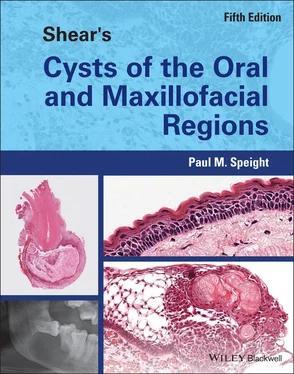Paul M. Speight - Shear's Cysts of the Oral and Maxillofacial Regions
Здесь есть возможность читать онлайн «Paul M. Speight - Shear's Cysts of the Oral and Maxillofacial Regions» — ознакомительный отрывок электронной книги совершенно бесплатно, а после прочтения отрывка купить полную версию. В некоторых случаях можно слушать аудио, скачать через торрент в формате fb2 и присутствует краткое содержание. Жанр: unrecognised, на английском языке. Описание произведения, (предисловие) а так же отзывы посетителей доступны на портале библиотеки ЛибКат.
- Название:Shear's Cysts of the Oral and Maxillofacial Regions
- Автор:
- Жанр:
- Год:неизвестен
- ISBN:нет данных
- Рейтинг книги:5 / 5. Голосов: 1
-
Избранное:Добавить в избранное
- Отзывы:
-
Ваша оценка:
- 100
- 1
- 2
- 3
- 4
- 5
Shear's Cysts of the Oral and Maxillofacial Regions: краткое содержание, описание и аннотация
Предлагаем к чтению аннотацию, описание, краткое содержание или предисловие (зависит от того, что написал сам автор книги «Shear's Cysts of the Oral and Maxillofacial Regions»). Если вы не нашли необходимую информацию о книге — напишите в комментариях, мы постараемся отыскать её.
Shear’s Cysts of the Oral and Maxillofacial Regions
Shear’s Cysts of the Oral and Maxillofacial Regions Fifth Edition
Shear's Cysts of the Oral and Maxillofacial Regions — читать онлайн ознакомительный отрывок
Ниже представлен текст книги, разбитый по страницам. Система сохранения места последней прочитанной страницы, позволяет с удобством читать онлайн бесплатно книгу «Shear's Cysts of the Oral and Maxillofacial Regions», без необходимости каждый раз заново искать на чём Вы остановились. Поставьте закладку, и сможете в любой момент перейти на страницу, на которой закончили чтение.
Интервал:
Закладка:
Although most types of odontogenic cyst arise from dental lamina, the most common cyst (radicular cyst) takes its origin from the rest cells of Malassez that lie in the periodontal ligament as remnants of Hertwig's root sheath (see Figure 3.6). The second most common cyst, the dentigerous cyst, arises from the reduced enamel epithelium that embraces the fully formed crown of a tooth prior to eruption. In the case of the radicular cyst, the phases of cyst formation and growth are well understood and are driven by inflammation that is initiated by bacterial factors emanating from a non‐vital pulp. This process is described in detail in Chapter 3. In developmental cysts, however, the processes are less clear, but are almost certainly driven by epithelial–mesenchymal interactions that initiate the molecular signalling pathways that underpin normal tooth development, morphogenesis, and eruption. Thus, the mechanisms of formation of developmental cysts can be regarded as the aberrant expression of normal processes.
Normal tooth eruption provides a good model of the epithelial–mesenchymal interactions that regulate tissue remodelling, including cell proliferation and bone resorption, and involve complex cascades and networks of cytokines, chemokines, and growth factors (Wise et al. 2002 ; Nel et al. 2015 ; Bastos et al. 2021 ). These biological factors are discussed in detail in the context of the radicular cyst ( Table 3.2), where the cascade is started by bacterial infection, but the same factors are involved in normal development and tooth eruption and contribute to the pathogenesis of developmental cysts. For example, Il‐1α is a pivotal pro‐inflammatory cytokine that can be activated by bacterial endotoxins, but it also has an important role as a paracrine signalling molecule in the dental follicle where, along with other factors (e.g. parathyroid hormone–related protein) it mediates tissue remodelling and bone resorption during tooth eruption via its role as an activator of osteoclasts.
These basic mechanisms of cytokine‐mediated tissue remodelling are involved in the growth and expansion of all types of cyst. These same biological factors are also responsible for proliferation of the reduced enamel epithelium that merges with the overlying oral epithelium during normal tooth eruption. It is thought that proliferation of the reduced enamel epithelium, in the absence of normal eruption, may be involved in the pathogenesis of the dentigerous cyst, but proliferation of rest cells of dental lamina within follicular tissue may also drive the formation of other lesions that are commonly associated with unerupted teeth. This would include some odontogenic tumours (e.g. ameloblastoma, adenomatoid odontogenic tumour) as well as the odontogenic keratocyst and orthokeratinised odontogenic cyst. The role of these biological factors in the pathogenesis of dentigerous cyst, the odontogenic keratocyst, and the orthokeratinised odontogenic cyst is discussed in Chapters 5, 7, and 12, respectively.
As well as activation of cytokines and other biological factors, there is good evidence that activation of oncogenic signalling pathways is a common feature in the pathogenesis of odontogenic cysts and tumours (Diniz et al. 2017 ; Bilodeau and Seethala 2019 ). These pathways are involved in the normal development and morphogenesis of the teeth, but aberrant activation may drive pathological processes. The most widely studied pathway is the hedgehog (HH) signalling pathway, which is a fundamental feature of normal development with crucial roles in cell fate, differentiation, and patterning. HH activation through binding of the Sonic hedgehog (SHH) ligand is a fundamental feature of odontogenesis, regulates the development of the dental lamina, and is responsible for tooth morphogenesis and patterning (Diniz et al. 2017 ; Seppala et al. 2017 ; Hovorakova et al. 2018 ; Sasai et al. 2019 ). The pathway is regulated by the PTCH protein, which is a receptor for SHH and under normal conditions controls and regulates epithelial–mesenchymal interactions, cell proliferation, and differentiation. The HH signalling pathway is discussed in detail in Chapter 7and is illustrated in Figure 7.13.
Constitutive or aberrant activation of the HH pathway can be caused by reduced expression or loss of the PTCH protein at the cell surface, and this is an important mechanism in the pathogenesis of the odontogenic keratocyst. Loss of PTCH most often results from loss of heterozygosity (LOH) or point mutations in the PTCH gene, and this is seen in up to 80% or more of keratocysts (see Table 7.6). However, although PTCH gene alterations are important in keratocysts, they are not specific, since mutations or LOH of PTCH or activation of the HH signalling pathway may be seen in other odontogenic lesions, including orthokeratinised odontogenic cyst (Vered et al. 2009 ; Diniz et al. 2011 ), glandular odontogenic cyst (Zhang et al. 2010 ), and dentigerous cyst (Levanat et al. 2000 ; Pavelić et al. 2001 ; Barreto et al. 2002 ; Vered et al. 2009 ; Zhang et al. 2010 ). The role of PTCH and the HH signalling pathway in these cysts is discussed in Chapters 5(dentigerous cyst), 10 (glandular odontogenic cyst), and 12 (orthokeratinised odontogenic cyst). The role of the B‐catenin gene ( CTNNB1 ) and the WNT signalling pathway in calcifying odontogenic cysts is discussed in Chapter 11.
Overall, it appears that alterations in the PTCH gene or activation of HH signalling are common features of a number of lesions and may represent an initiating event in the formation of developmental odontogenic cysts, possibly in a progenitor epithelial cell, which then gives rise to the entire epithelial lining and drives growth and expansion. It has been suggested that the PTCH gene may act as a gatekeeper gene and that further genetic events result in the formation of different cysts or tumours (Gomes and Gomez 2011 ). This would explain a role for PTCH in a wide range of cyst types, but does not exclude a role for further specific PTCH mutations in keratocysts.
Another unifying feature involved in the pathogenesis of jaw cysts and probably also of soft tissue cysts is the role of hydrostatic pressure. With few exceptions (odontogenic keratocyst, botryoid odontogenic cyst, glandular odontogenic cyst), cysts in the jaws tend to be round or spherical on radiology or imaging, suggesting that they grow slowly in a regular and centripetal manner. It is widely accepted that hydrostatic pressure due to osmosis provides the evenly distributed internal forces that result in this growth pattern. Osmotic pressure across the cyst wall is caused by the accumulation of soluble proteins in the cyst lumen, so that the concentration of molecules inside the cyst is greater than in the adjacent tissues. This causes passage of fluid (water) into the cyst lumen and results in a high intraluminal pressure that drives cyst expansion and growth. The mechanisms of hydrostatic pressure and its role in the radicular cyst are discussed in detail in Chapter 3, but there is good evidence that hydrostatic pressure due to osmosis is involved in the expansion of most, if not all, cyst types. Although the odontogenic keratocyst grows in a multicentric pattern associated with cell proliferation in the wall, there is also evidence of an increased intracystic pressure, suggesting a role for osmosis in its expansion (Toller 1970b ; Kubota et al. 2004 ). Kubota et al. (2004 ) suggested that increased hydrostatic pressure was particularly important in the initiation and early growth of the keratocyst, while cell proliferation was more important as the cyst enlarged. This is in keeping with the observation that keratocysts tend to be unilocular when they are small, while larger cysts and lesions in older individuals are more often multilocular or scalloped (Forssell 1980 ; Stoelinga 2001 ; MacDonald‐Jankowski and Li 2010 ; Boffano et al. 2010 ; see Chapter 7). Interestingly, Kubota's research group (Kubota et al. 2004 ; Oka et al. 2005 ) also showed that the increased pressure stimulated secretion of cytokines, including IL‐1α, suggesting another common mechanism for activation of biological factors that promote tissue remodelling and bone resorption. These data are discussed in detail in Chapter 7.
Читать дальшеИнтервал:
Закладка:
Похожие книги на «Shear's Cysts of the Oral and Maxillofacial Regions»
Представляем Вашему вниманию похожие книги на «Shear's Cysts of the Oral and Maxillofacial Regions» списком для выбора. Мы отобрали схожую по названию и смыслу литературу в надежде предоставить читателям больше вариантов отыскать новые, интересные, ещё непрочитанные произведения.
Обсуждение, отзывы о книге «Shear's Cysts of the Oral and Maxillofacial Regions» и просто собственные мнения читателей. Оставьте ваши комментарии, напишите, что Вы думаете о произведении, его смысле или главных героях. Укажите что конкретно понравилось, а что нет, и почему Вы так считаете.












